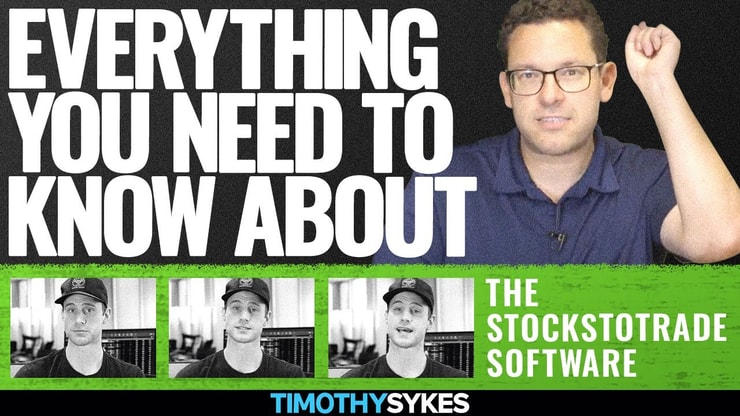Can AI predict the stock market? It can analyze more data than any one of us ever could, but that doesn’t make it a crystal ball. As traders, we don’t predict — we react. But can AI understand the market better than our puny human brains? Let’s break it down.
Check out my AI penny stock watchlist here!
Read this article because it breaks down how AI analyzes stock market data — from technical indicators to Twitter sentiment — so you can understand where machines really add value in trading decisions.
I’ll answer the following questions:
- Can AI predict the stock market with real accuracy?
- How does AI process technical indicators like RSI and MACD?
- What role does fundamental data play in AI market predictions?
- Can AI read market sentiment from Reddit and news headlines?
- How does macroeconomic data factor into AI trading models?
- What is alternative data and how do AI systems use it?
- Which AI trading platform is best for beginners?
- What are the real benefits and limits of using AI to predict stock prices?
Let’s get to the content!
Table of Contents
- 1 How Does AI Analyze The Stock Market?
- 2 Key Data AI Uses to Predict Stock Prices
- 3 Best AI Trading Platform for Beginners
- 4 Benefits of Using AI to Predict Stock Market
- 5 Limitations of Using AI to Predict Stocks
- 6 How Does the Future Look for AI in Stock Market Predictions
- 7 Key Takeaways
- 8 Frequently Asked Questions
- 8.1 How does artificial intelligence handle complex market movements?
- 8.2 Can AI help improve trading strategies and portfolio management?
- 8.3 Does AI take risk tolerance into account when making predictions?
- 8.4 Can AI help maximize returns from dividends, assets, or long-term positions?
- 8.5 What role does AI play in high-frequency trading?
How Does AI Analyze The Stock Market?
AI analyzes the stock market using data-driven models trained to identify patterns in price movements and market behavior. These systems aren’t about gut feelings or hype — they’re about data, probability, and the power of finance algorithms to process millions of variables in seconds. From price charts to earnings reports, from social sentiment to inflation data, AI systems are designed to pick up patterns that the average trader might miss.
In over two decades of trading and teaching, I’ve seen how pattern recognition is the foundation of consistent gains. Now, machine learning models can be trained on those same setups. The difference? They don’t get tired, they don’t panic, and they don’t revenge trade. But they also can’t adapt to breaking news or unpredictable spikes without guidance — and that’s where human traders still have an edge.
XGPT is the AI tool my team and I have built to spot high-odds stock setups — faster, smarter, and more efficiently than any human can. You don’t have to be a math genius or some tech wizard. XGPT analyzes patterns, price action, and data the way my top students do… only it does it 1,000x faster.
Whether you like it or not, AI is part of modern trading. Other traders are already using it, shouldn’t you?
Key Data AI Uses to Predict Stock Prices
AI tools rely on several data types to forecast stock prices. These include technical indicators, fundamental metrics, market sentiment, macroeconomic conditions, and even unconventional sources like satellite imagery and transaction data. AI systems learn from historical patterns and use predictive modeling to estimate the probability of specific price movements or market trends.
From my experience, the more high-quality data you feed into your system — whether it’s your brain or a machine — the better your decisions become. That’s what I teach every student. Train your brain with data and patterns, and now, train your tools to do the same.
Technical Indicators
Technical indicators are some of the most common signals used by AI models to forecast trades. Moving averages, like the SMA (Simple Moving Average) and EMA (Exponential Moving Average), are foundational. The SMA smooths out noise by averaging price over time, while the EMA reacts faster to price changes. Both are used to identify trend direction and possible reversal points. My students and I rely on these every day, and AI models do the same — only they can compute them across thousands of stocks simultaneously.
RSI and MACD offer a different kind of insight. RSI (Relative Strength Index) tells you if a stock is overbought or oversold — critical for spotting exhaustion before a reversal. MACD (Moving Average Convergence Divergence) is all about momentum and crossover signals. Bollinger Bands help identify volatility and potential breakouts, while volume indicators can confirm the strength behind a move. These tools aren’t just chart overlays — they’re rule-based triggers that AI systems scan for around the clock.
In addition to traditional indicators like RSI and MACD, AI tools are now incorporating newer, hybrid signals that combine volume, volatility, and sentiment into single metrics. For example, some models track the relative strength of high-volume breakouts across small caps, helping to flag momentum shifts that human traders might miss. These signals aren’t replacements for solid setups — they’re amplifiers. When a classic breakout aligns with a surge in sentiment-weighted volume, that’s a setup worth watching.
To learn more about how AI systems can be taught to follow specific trading patterns, check out how I use AI to trade stocks.
Fundamental Data
AI also integrates fundamental data into its predictive analysis. It reviews earnings reports, profit margins, and company revenue trends to assess whether a stock is undervalued or overpriced. It’s not about finding the next blue-chip — it’s about knowing when good or bad financials might lead to a big price reaction.
Price-to-earnings (P/E) ratios and other valuation metrics are key factors in AI models. When combined with company-specific news, this kind of data can help the model weigh short-term risk against long-term strength. As a trader, I’ve always looked for catalysts. Now, AI can help sift through thousands of earnings reports and headlines to spot the ones that actually matter.
It’s also important to use a trading platform that provides real-time data.
When it comes to trading platforms, StocksToTrade is first on my list. It’s a powerful day and swing trading platform that integrates with most major brokers. I helped to design it, which means it has all the trading indicators, news sources, and stock screening capabilities that traders like me look for in a platform.
Grab your 14-day StocksToTrade trial today — it’s only $7!
More Breaking News
- AeroVironment Stock Surges as Q4 Earnings Beat Wall Street Expectations
- Cleveland-Cliffs Stock Surges After Tariff News
- DNN’s Surprising Stock Jump: What’s Behind It?
Sentiment Analysis
Sentiment analysis is one of the most exciting areas where AI is changing the game. AI models use natural language processing (NLP) to read headlines, analyst reports, and even social media posts from Twitter or Reddit. They quantify emotional tone and volume to detect bullish or bearish market sentiment.
In volatile penny stock trades, sudden shifts in sentiment can trigger massive price swings. AI models trained to measure spikes in hype or fear can catch potential moves earlier than most retail traders. But it’s still on you to act — even if an algorithm picks up on excitement, it takes a disciplined trader to know when to buy, when to sell, and when to just walk away.
Macroeconomic Data
Macroeconomic data is another key input. AI systems monitor interest rates, GDP growth, CPI (inflation), and unemployment reports for shifts in the broader market environment. These factors drive overall market conditions, which can affect the probability of upward or downward price action across entire sectors.
Traders who ignore macro data do so at their own risk. Whether it’s the Fed hiking rates or a surprise jobs report, these events shake the entire market. AI systems don’t panic — they adjust their forecasts instantly. That said, most AI tools still rely on you to interpret those forecasts with context and make smart trading decisions.
Alternative Data
AI also taps into alternative data sources — like satellite images of parking lots, credit card transactions, and Google search trends — to get ahead of earnings surprises or business shifts. These datasets aren’t traditional, but they offer an edge when interpreted correctly.
For example, if AI models see a drop in foot traffic to retail stores or a surge in online orders, that could signal strength or weakness before it hits the earnings report. I’ve always taught traders to look beyond the obvious. Now, AI helps automate that principle — scanning thousands of unconventional signals to give you better odds.
Best AI Trading Platform for Beginners
For beginners, the best AI trading platforms are the ones that combine simplicity with strong data-driven insights. Tools like XGPT — developed from my own 7-Step Framework — are built to give new traders clear, pattern-based trade plans. These platforms do the heavy lifting by analyzing data, mapping out risk, and offering setups with real-time probabilities.
httpv://www.youtube.com/watch?v=shorts/GE3045I9Yqg
When you’re just starting, the goal isn’t to be perfect — it’s to build experience without blowing up your account. That’s why I designed these tools to follow my rules: trade plans with set entries, exits, and stop losses, based on pattern recognition and historical performance. They’re not magic, but they’re powerful if used correctly.
Benefits of Using AI to Predict Stock Market
Using AI in trading has real benefits. It can process vast amounts of market data at speeds humans can’t match. It spots price discrepancies, detects patterns, and tracks sentiment across thousands of sources in real time. This means faster insights, better timing, and a stronger edge.
AI also removes emotional decision-making. It won’t hesitate, second-guess, or get greedy. And when it’s paired with your trading rules, it becomes a force multiplier. That’s how my students use XGPT — not as a crutch, but as a tool to enhance decision-making and manage trades more efficiently.
Another benefit of AI is how it helps you backtest smarter. With the right tools, you can analyze thousands of past trades across different market conditions — not just to see what worked, but to understand why it worked. This helps refine your setups and avoid chasing random patterns. Backtesting isn’t just for quants anymore. AI platforms now make it easy for everyday traders to simulate trades based on historical data, which is key for improving confidence and consistency.
To explore more practical ways AI enhances pattern recognition, read this guide on AI stock analysis techniques.
Limitations of Using AI to Predict Stocks
AI is not foolproof. These systems are only as good as the data they’re fed and the models they’re trained on. Garbage in, garbage out. If an AI model is trained on flawed or biased data, its predictions will reflect that. And most can’t fully account for black swan events or breaking news that shocks the market.
AI also lacks human judgment. It doesn’t understand the context of a tweet or the weight of a breaking SEC filing unless it’s been specifically trained for it. That’s why traders who blindly follow AI signals without thinking for themselves often get burned. Use the tools, but always stay in control.
How Does the Future Look for AI in Stock Market Predictions
The future of AI in stock trading is expanding fast. Neural networks and deep learning models like LSTM and SVM are getting better at forecasting short-term movements. Platforms that combine price, news, sentiment, and alternative data are outperforming older tools. But we’re still early. Most of these models need better feature selection, cleaner data, and more testing.
Traders who stay ahead of the curve and learn how to use these systems will have an advantage. That’s why I’ve been investing in AI development for years — not because I expect it to replace traders, but because I know it can help us react faster and smarter. The better your tools, the better your results.
Key Takeaways
AI can’t predict the future — but it can increase your odds by analyzing more market factors, faster and more consistently than any human. Use it to improve your setups, tighten your risk management, and enhance your trade planning. But never forget: it’s just a tool. The trader — with discipline, pattern recognition, and a solid plan — still makes the trade.
Trading isn’t rocket science. It’s a skill you build and work on like any other. Trading has changed my life, and I think this way of life should be open to more people…
I’ve built my Trading Challenge to pass on the things I had to learn for myself. It’s the kind of community that I wish I had when I was starting out.
We don’t accept everyone. If you’re up for the challenge — I want to hear from you.
Apply to the Trading Challenge here.
Trading is a battlefield. The more knowledge you have, the better prepared you’ll be.
Are you using AI the smart way to boost your odds? Write “I’ll keep it simple Tim!” in the comments if you picked up on my trading philosophy!
Frequently Asked Questions
How does artificial intelligence handle complex market movements?
Artificial intelligence models are designed to manage complexity by analyzing vast amounts of market data, identifying subtle patterns, and adapting to shifts in market movements faster than humans can. These AI tools use layered algorithms to process signals from multiple sources, helping traders make more accurate and timely decisions. While not perfect, their ability to filter noise and improve accuracy gives traders a measurable edge in volatile environments.
Can AI help improve trading strategies and portfolio management?
Yes, AI can enhance trading strategies by identifying high-probability setups and optimizing portfolio management through real-time analysis of price action and performance data. It can also adjust strategies based on volatility, sector rotation, and news sentiment, helping traders balance gains and risk. When used correctly, AI models support disciplined decision-making and reduce emotional errors in managing a trading portfolio.
Does AI take risk tolerance into account when making predictions?
Most advanced AI systems can be calibrated to align with a trader’s risk tolerance by adjusting stop-loss levels, position sizing, and trade frequency. This allows for a customized trading experience, whether you’re aggressive or conservative. But it’s still the trader’s job to understand their own risk profile and use AI tools as a support, not a substitute, for personal responsibility.
Can AI help maximize returns from dividends, assets, or long-term positions?
AI isn’t limited to short-term trading — it can analyze asset quality, dividend reliability, and historical returns to help guide long-term decisions. Some AI models focus on identifying stable income-producing assets that align with specific financial goals. However, traders should remember that market conditions change, and even the best models need regular review and adjustment.
What role does AI play in high-frequency trading?
In high-frequency trading, AI is essential for scanning market conditions, identifying price inefficiencies, and executing orders in milliseconds. These AI-driven systems can outperform humans in speed and precision, especially when trading small spreads across liquid assets. But with speed comes risk — without proper oversight, these algorithms can misfire, especially during unexpected news events or flash crashes.











Leave a reply